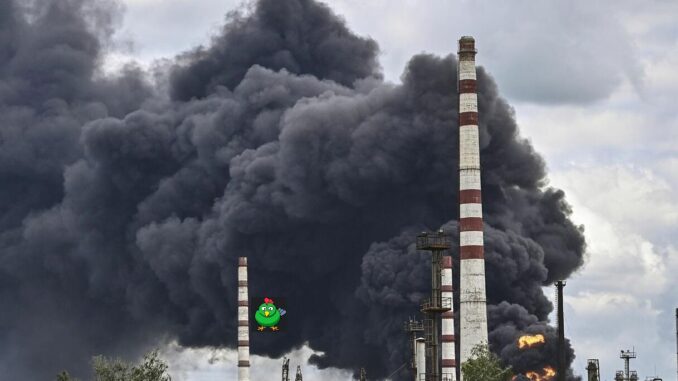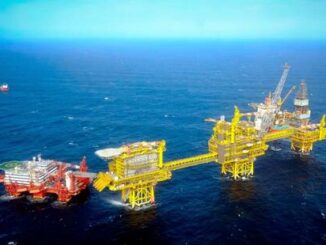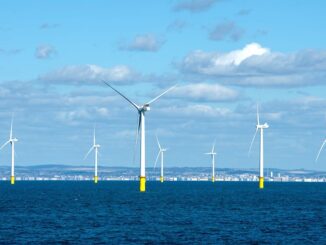
In a bold escalation amid the ongoing Russia-Ukraine conflict, Ukrainian President Volodymyr Zelensky has announced plans to broaden the scope of long-range strikes targeting Russian oil refineries. This declaration, made following a strategic meeting with his military staff, underscores Ukraine’s intent to intensify pressure on Russia’s energy sector, which Zelensky claims is already “paying a tangible price for the war—and will pay even more.”
As the war enters its fourth year, these attacks have become a near-nightly occurrence, with Ukrainian forces deploying drones and missiles to disrupt Russian fuel production and logistics.
This move comes at a time when global energy markets are watching closely, as strikes on refineries could ripple through oil prices and supply chains. Drawing from recent analyses and expert discussions, including an interview with energy analysts Doomberg, David Blackmon, and Stu Turley, this article examines the pattern of these strikes, the authorizations behind them, and the strategic motivations driving Ukraine’s campaign.
The Strategic Rationale: Insights from Energy Experts
In a recent interview on the Energy News Beat podcast, Doomberg and his co-hosts delved into the “gloves-off” dynamics of the conflict, highlighting how Ukraine’s focus on Russian refineries represents a calculated approach.
Rather than targeting crude oil production—which could spike global prices and provoke severe retaliation—Ukraine has prioritized refineries to achieve visible “media victories” through dramatic explosions, while minimizing broader disruptions. This strategy, likely coordinated with U.S. input, allows Russia to redirect excess crude to allies like China, which has significant unused refining capacity (around 18 million barrels per day).
The experts emphasized that these attacks serve as a “forcing function” in the war of attrition, pressuring Russia without crossing thresholds that might lead to full-scale fuel shortages domestically. However, they also warned of escalation risks, noting Russia’s advantages in drone production and Ukraine’s resource constraints. Broader geopolitical factors, including U.S. political shifts under President Trump and European deindustrialization due to high energy costs, frame these strikes as part of a proxy war where Western powers guide target selection to avoid direct involvement.
Got Questions on investing in oil and gas? Tis the season for Tax Prep
A Chronology of Strikes: Targeting Russian and Russian-Linked Refineries
Ukraine’s campaign against Russian energy infrastructure has intensified significantly since early 2024, with drones and missiles hitting refineries deep inside Russian territory and even extending to Russian-owned or linked facilities in other countries. According to various reports, Ukraine has conducted over 60 drone strikes on refineries since January 2024, with a surge in 2025 knocking out up to 20% of Russia’s refining capacity—equivalent to about 1.2 million barrels per day.
August 2025 saw a record 14 refineries targeted, followed by eight in September.
Here’s a compiled list of notable strikes, drawing from documented incidents (note: this is not exhaustive, as some attacks remain unconfirmed or classified):
Strikes Inside Russia (2024-2025):
January 18, 2024: Saint Petersburg Oil Terminal hit by drones.
January 24, 2025: Ryazan Oblast refinery (Rosneft) attacked by at least 12 UAVs; also targeted Novo-Ryazanskaya thermal power plant.
Recent strikes in October 2025 disrupted 80,000 bpd at this site, Russia’s fourth-largest refinery.
September 20, 2025: Novokuybyshevsk refinery in Samara Oblast struck, killing four and injuring one.
Overall 2024-2025: At least 37 successful drone strikes on 16 refineries by mid-2025, with 58 attacks reported since August 2025 alone, some reaching 2,000 km into Russia.
These have contributed to gasoline shortages in Russia and occupied Ukraine.
Strikes on Russian-Linked Refineries in Other Countries:
Ukraine’s reach has extended beyond Russia’s borders, targeting facilities processing Russian oil in EU nations. This marks a new phase, potentially aimed at disrupting Russia’s export revenues amid U.S. sanctions on entities like Lukoil and Rosneft.
August 19, 2025: Druzhba pipeline, carrying Russian oil to Hungary and Slovakia, struck—prompting outrage from Hungarian officials over the widening conflict.
October 20, 2025: Explosions at MOL refinery in Hungary (processes Russian crude via Lukoil) and a refinery in Romania (also tied to Russian oil). These incidents, occurring hours apart, sparked sabotage suspicions and investigations, coming days before a potential peace summit.
Fires and blasts disrupted operations, highlighting vulnerabilities in Europe’s lingering reliance on Russian energy.
These extraterritorial strikes underscore Ukraine’s evolving tactics, using long-range capabilities to hit Russian economic interests wherever they exist.
Who Authorized These Strikes? The Role of Western Missiles
The authorizations for Ukraine’s use of long-range weapons have evolved amid shifting U.S. administrations. In late 2024, under President Joe Biden, Ukraine received approval to deploy U.S.-supplied ATACMS missiles against targets inside Russia, marking a significant policy shift.
This paved the way for similar permissions on British Storm Shadow missiles, supplied by the UK following Kyiv’s requests.
Recent reports confirm Ukraine has unleashed Storm Shadow missiles on Russian territory, with the UK’s authorization allowing strikes deep into enemy lines.
Under President Trump in 2025, there have been mixed signals: initial quiet restrictions by the Pentagon on ATACMS use,
followed by a recent lifting of key barriers, enabling deeper strikes.
Trump has also weighed providing even longer-range Tomahawk missiles, though no approval has been confirmed.
U.S. intelligence continues to assist in targeting, as noted in Zelensky’s push for expanded capabilities.
British Storm Shadow missiles, with their precision and range, have been central to recent refinery attacks, authorized by the UK to help Ukraine “change the course of the war.”
The Storm Shadow missile, a British-French cruise missile supplied to Ukraine, incorporates a multi-layered guidance system including inertial navigation (INS), GPS, terrain contour matching (TERCOM/TERPROM), and an imaging infrared (IIR) seeker for the terminal phase. This design allows it to operate as a fire-and-forget weapon, pre-programmed with target coordinates before launch.
However, its full precision relies on classified US-owned cartographic data for the TERCOM system, which enables low-altitude terrain-following flight to evade defenses.
Exports and use are subject to US restrictions under International Traffic in Arms Regulations (ITAR), and without this data, the missile falls back to less resilient GPS/INS modes, making it vulnerable to Russian electronic warfare and jamming.
In the context of Ukraine’s operations, effective targeting—including accurate coordinates, terrain mapping, and real-time intelligence for route planning and target verification—typically depends on US-provided data, such as satellite imagery, encrypted military GPS signals (M-code), and surveillance from assets like AWACS planes.
Without this, strikes are less precise, with potential for navigation errors, increased failure rates, or reduced mission success against hardened or distant targets.
Ukraine could theoretically use alternative sources (e.g., its own drones, agents, or European satellites from allies like France or Finland) for basic targeting, but these lack the depth and timeliness of US intelligence, rendering the missiles far less effective for deep strikes into Russia.
Recent policy shifts under the Trump administration illustrate this dependency: initial restrictions on US data sharing reportedly made Storm Shadows “useless” for certain operations, though a quiet lifting of barriers in late 2025 has enabled resumed use with US support.
While not impossible to launch without US involvement, the missiles cannot be used with their intended precision and reliability absent American intelligence and targeting assistance.
Why these authorizations? Western leaders aim to bolster Ukraine’s defense without direct troop involvement, forcing Russia into negotiations amid mounting economic strain. As Doomberg noted, the U.S. is effectively “planning this and telling Ukraine what they can and cannot hit,” balancing escalation with energy market stability.
Why Limited Impact on Crude Prices?
The strikes primarily target refining infrastructure rather than crude oil production, allowing Russia to redirect excess crude to export markets.
This strategic choice minimizes disruptions to global crude supply, as damaged refineries lead to reduced domestic processing but increased crude exports. For instance:
Russia has curbed diesel exports in response to the attacks, prioritizing domestic needs amid rising internal fuel prices and shortages.
However, global crude inventories are rising, driven by non-OPEC+ production growth (e.g., U.S. output hitting record highs above 13.6 million b/d in July 2025) and OPEC+ gradually unwinding cuts.
This oversupply is forecasted to add 2.0 million b/d in 2025 and 0.7 million b/d in 2026 from non-OPEC+ sources.
Economically, while the attacks introduce some upward pressure on prices due to reduced refined product availability (e.g., diesel and gasoline), broader factors like slowing demand from China and increased global production capacity outweigh this. Analysts suggest the strikes could be “too successful” in pressuring Russia, potentially influencing U.S. policy under President Trump to limit escalation and stabilize markets.
reuters.com
Effects on Refined Products and Broader Markets
The more pronounced impact is on refined products:
Russian oil product exports fell sharply, exacerbating regional shortages and pushing up diesel prices in Europe and beyond.
Global diesel and gasoline markets may see localized price increases, but crude remains depressed as Russia pivots exports to countries like China, which has ample refining capacity.
Why Now? Motivations and Broader Implications
Zelensky’s expansion declaration is driven by the need to sustain momentum in a protracted conflict, where Ukraine faces infrastructure devastation and resource shortages.
By targeting refineries, Kyiv seeks to erode Russia’s war funding—oil revenues fuel Moscow’s military machine—while avoiding global backlash from crude supply disruptions. This aligns with U.S. and European goals of weakening Russia economically, as evidenced by new sanctions on Lukoil and Rosneft.
However, risks abound: fuel shortages in Russia could harden Putin’s stance, and strikes in EU countries like Hungary raise sabotage fears, potentially straining NATO alliances.
As peace efforts falter, these attacks may accelerate a bifurcation in global energy markets, pushing the West toward independence while Russia pivots to Asia.
The Bottom Line
Zelensky’s push reflects a high-stakes gamble, authorized by key Western allies using missiles like Storm Shadow and ATACMS, to impose costs on Russia and shift the battlefield dynamics. The energy world watches as refineries burn, wondering if this will force a breakthrough or further entrench the conflict.
Ukrainian strikes have inflicted significant damage on Russian refining—potentially costing Moscow billions in lost revenue—the global crude oil market has absorbed these shocks without major price surges. Instead, prices are declining amid abundant supply, with forecasts pointing to further softening into 2026. This underscores the targeted nature of the campaign, designed to hurt Russia’s war economy without broadly destabilizing international energy markets.
Got Questions on investing in oil and gas?
Crude Oil, LNG, Jet Fuel price quote
ENB Top News
ENB
Energy Dashboard
ENB Podcast
ENB Substack







